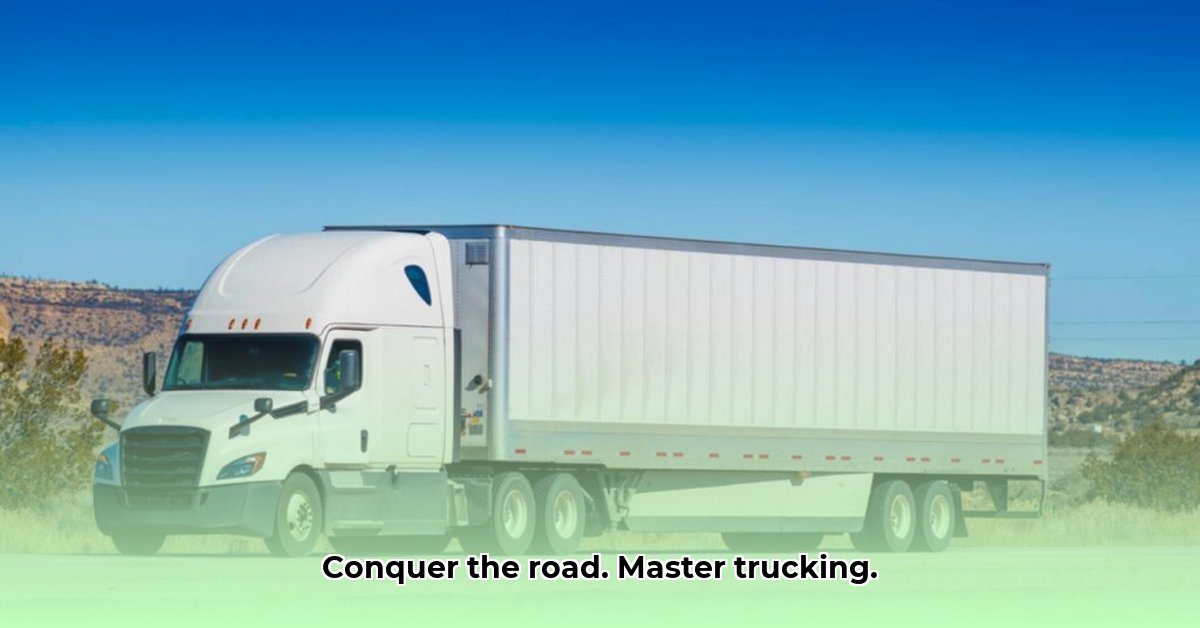
A Tractor-Trailer: Understanding the King of the Road
Tractor-trailers, those behemoths of the highway, are the backbone of freight transport. Understanding their operation, from basic mechanics to complex regulations, is crucial for anyone involved in or interested in the logistics industry. This guide provides a comprehensive overview, making complex topics accessible to everyone, from complete novices to seasoned professionals. For more on trailer dimensions, check out this helpful resource on tractor trailer lengths. Did you know that tractor-trailers move nearly everything you consume daily? This underscores their critical role in global commerce.
Dissecting the Behemoth: Tractor-Trailer Anatomy
A tractor-trailer consists of two main parts: the tractor (the power unit) and the trailer (the cargo carrier). The tractor houses the engine, transmission, and driver's compartment. The trailer, however, comes in many variations, each optimized for specific cargo.
Common Trailer Types:
- Dry Vans: Enclosed trailers ideal for general cargo, protecting goods from the elements. Think clothing, electronics, packaged goods.
- Refrigerated Trailers ("Reefers"): Temperature-controlled trailers essential for preserving perishable goods like food and pharmaceuticals.
- Flatbeds: Open trailers perfect for oversized or irregularly shaped loads, such as construction materials or heavy machinery.
- Tankers: Specialized trailers designed to transport liquids or gases, like fuel or chemicals.
Visual: (Diagram illustrating the different trailer types and their key features would be inserted here.)
The tractor's engine, typically a heavy-duty diesel, provides the power. The transmission manages power delivery to the wheels, crucial for navigating varied terrain and load weights. Other critical systems include the braking system, suspension, and electrical components.
Quantifiable Fact: (Insert a statistic from the draft article, relating to the power of a typical tractor-trailer engine or the weight it can haul.)
More Than Just Driving: Operating a Tractor-Trailer
Operating a tractor-trailer requires significantly more skill than driving a car. Before starting, a thorough pre-trip inspection is mandatory—a crucial safety step that checks tires, lights, fluids, and other components.
Numbered Steps for Pre-Trip Inspection:
- Tires: Check tire pressure and tread depth. (Note: Proper inflation is crucial for fuel efficiency)
- Lights: Verify all lights (headlights, brake lights, turn signals) are functioning correctly.
- Fluids: Check engine oil, coolant, brake fluid, and power steering fluid levels.
- Brakes: Test the service and parking brakes.
- Undercarriage: Inspect for damage or leaks underneath the vehicle.
Expert Quote: (Insert quote from a trucking safety expert emphasizing the importance of pre-trip inspections and their contribution to accident avoidance.)
Coupling and uncoupling the trailer requires precision to avoid damage. Maneuvering a tractor-trailer demands practice and awareness of its size and blind spots. Regular maintenance is critical for both safety and fuel efficiency.
Data-backed Rhetorical Question: Isn't preventative maintenance crucial for maximizing a tractor-trailer's lifespan and fuel economy? (Reference a statistic about the cost savings associated with preventative maintenance.)
Load securing is paramount to prevent shifting cargo and potentially catastrophic accidents. Specific techniques will be discussed in a later section.
The Rules of the Road: Regulations, Safety, and Technological Advancements
The trucking industry is heavily regulated. Hours-of-service (HOS) rules limit driving time to combat driver fatigue. Strict weight limits protect infrastructure. Safety regulations, including vehicle inspections and driver training, are constantly evolving.
Technological Advancements:
- Telematics: GPS trackers and diagnostics improve efficiency and safety by monitoring vehicle performance and driver behavior.
- Autonomous Driving: Emerging technology promising increased safety and efficiency, although challenges remain concerning ethical considerations and job displacement.
- Alternative Fuels: Natural gas and electric trucks offer more sustainable alternatives, though infrastructure limitations are significant barriers.
Human Element: (Share a brief anecdote about a driver successfully using telematics to avoid a potential accident.)
The Bottom Line: Economic and Environmental Considerations
The economic impact of trucking is substantial, encompassing fuel costs, driver salaries, maintenance, and insurance. Comparing trucking to other freight modes highlights its cost-effectiveness for long-distance hauls. However, the environmental impact, primarily diesel emissions, is a concern driving the adoption of cleaner technologies.
The Future of the Road: A Technological Crossroads
The trucking industry stands at a technological crossroads. Autonomous driving and alternative fuels promise significant improvements, but challenges related to implementation and infrastructure remain. The industry will continue to evolve, demanding continuous adaptation and innovation.
This guide provides a foundational understanding of the complex world of tractor-trailers. The industry's dynamic nature necessitates continuous learning to stay abreast of advancements and regulations.